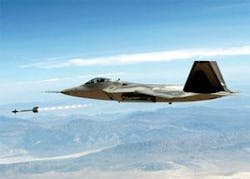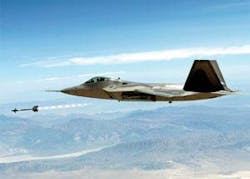First air-to-air missile defense system intercepts boosting missile
By Courtney E. Howard
WASHINGTON—The first air-to-air intercept of a ballistic missile target by a missile defense system took place last month at the White Sands Missile Range, N.M.
A U.S. Air Force F-16 jet fighter launched two air-to-air AIM-9X missiles, which in turn intercepted a boosting rocket launched from the White Sands Missile Range. The event marked the first time that an aircraft made a missile-defense intercept.
The AIM-9X Sidewinder is a fifth-generation high off-boresight, thrust-vectored, air-to-air missile produced by engineers at the Raytheon Co. Missile Systems Air-to-Air segment in Tucson, Ariz. The short-range, launch-and-leave missile uses passive infrared (IR) sensors for acquisition and tracking, and incorporates a 20-pound explosive warhead.
It further offers high off-boresight capability, an agile airframe, a fifth-generation seeker, and thrust vectoring control. It is well suited to near beyond visual range (NBVR) and within visual range (WVR) arenas, and its IR countermeasures deliver the capacity to resist ever-changing threats.
“AIM-9X, the next-generation Sidewinder missile, has truly changed the rules of air combat,” says a Raytheon representative.
A liquid propellant in the two-stage, air-to-air missile’s second stage rocket motor provides the velocity necessary to intercept missiles in their initial boosting stage, reports Riki Ellison, president of the Missile Defense Advocacy Alliance (MDAA) in Alexandria, Va. “Not only can the AIM-9X terminate missiles in the boosting phase, it is also effective in the descent and terminal phase of a ballistic missile.”
This missile defense system, called the Network Centric Airborne Defense Element (NCADE), can be used on current and future U.S. aircraft, including the F-15, F-16, F/A-18, F-22, and F-35, as well as unmanned aerial vehicles (UAVs).
“Currently [the U.S.] government is investing in the future development of several boost-phase systems of which the Airborne Laser (ABL) is the primary element,” continues Ellison. “Other future boost phase elements include the Kinetic Energy Interceptor (KEI) with a high-acceleration booster rocket system. All of these future boost-phase missile defense systems have mobility and high velocity as the key common trait.”
It is important that the U.S. government continue to research, develop, and test boost-phase missile defense systems, according to Ellison. “Adding this layer can increase the effectiveness of the missile defense system as a whole, and help take away today’s threat of ballistic missiles and the future threat of ballistic missiles that may have multiple maneuverable warheads and sophisticated decoys.”
AIM-9X is a joint U.S. Navy and U.S. Air Force program; the Navy is designated as the Executive Service. Raytheon Co. is the prime contractor. The AIM-9 Sidewinder, currently in use by more than 40 nations around the world, is a product of Raytheon Missile Systems.
For more information, visit the Missile Defense Advocacy Alliance online at www.missiledefenseadvocacy.org.

